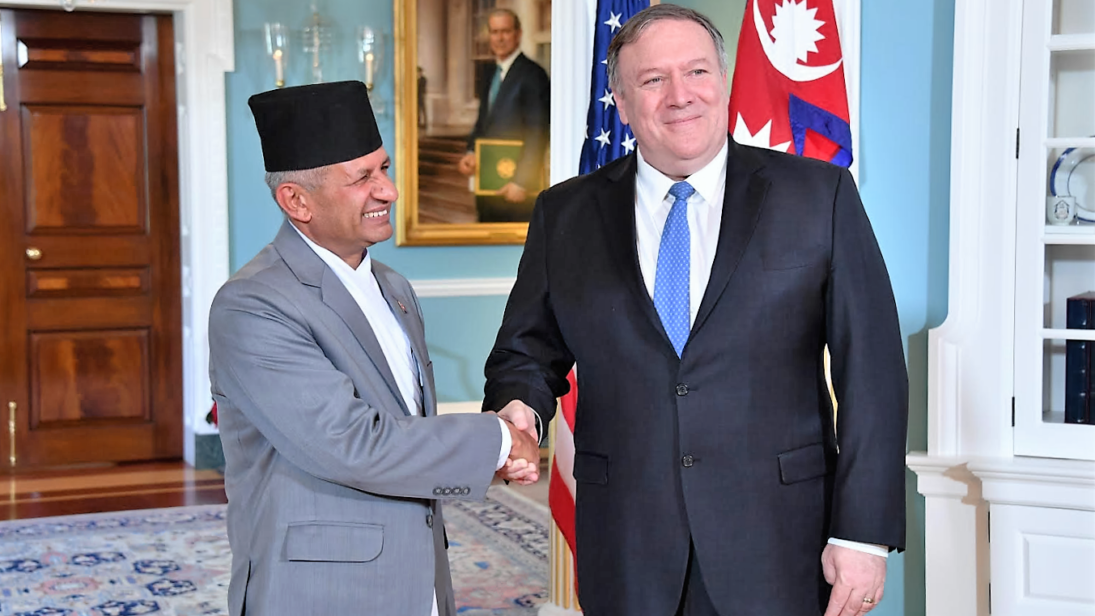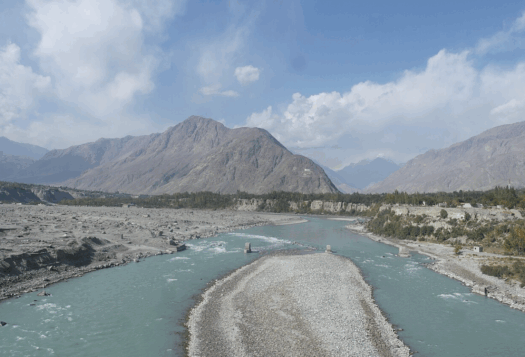
With the new government led by Nepal Communist Party Chairman (NCP) KP Sharma Oli completingone year in office last month, novel foreign policy challenges have unfolded before the government as it strives to fulfill the unmet development aspirations of the people of Nepal, including the herculean task of balancing major powers India, China, and the United States.
In this backdrop, the United States, a major and longstanding development partner of Nepal, has showed renewed interest in the Himalayan country, increasing both its engagement with and investment as part of its new Asia strategy. Kathmandu, however, cannot afford to take sides between the competing visions of the U.S. Indo-Pacific Strategy and China’s Belt and Road Initiative (BRI). The government of Nepal should act in a manner that keeps its national interest at the center of its interactions with those countries.
TheTug-of-War Between Strategies
The Indo-Pacific concept, introduced by the Trump Administration, entails the United States, India, Japan, Australia, and other democratic countries partnering to contain Chinese influence in the region. For the countries of the region, the Indo-Pacific Strategy and BRI appear to be in competition with one another, as both are pushing connectivity and development infrastructure initiatives. China has already invested in the smaller countries like Nepal, the Maldives, Sri Lanka, and other countries, while the United States and its regional partners are pushing development and connectivity projects to these same countries.
In the past few weeks, the rivalry between the Indo-Pacific strategy and China’s BRI has clearly surfaced in Nepal upon a flurry of activity in U.S.-Nepal relations, as Nepal’s Foreign Minister paid a visit to Washington in December and the U.S. Deputy Assistant Secretary of Defense for South and Southeast Asia visited Kathmandu in February.
In the meeting between U.S. Secretary of State Mike Pompeo and Nepal’s Foreign Minister Pradeep Gyawali, the two leaders apparently discussed bilateral relations and Nepal’s role in America’s Free and Open Indo-Pacific Strategy. In a recent interview with Annapurna Express, a weekly English daily newspaper, Gyawali said of the meeting that, “American officials wanted Nepal to give more attention to fair business and competitiveness when development projects are selected.” In a clear indication towards China’s BRI, Gyawali added that American officials also “advised that Nepal should think of its pay-back capacity on development projects.”
Soon after Gyawali’s visit to Washington, there was pressure from ruling party leaders on Nepal’s government from ruling and opposition party leaders to clarify what the American statement about the meeting meant for Nepal. There was also pressure by Nepal’s ruling party leaders not to support the Indo-Pacific Strategy because it aims to undercut Chinese influence in Nepal.
Soon after Gyawali’s visit to Washington, there was pressure from ruling party leaders on Nepal’s government from ruling and opposition party leaders to clarify what the American statement about the meeting meant for Nepal. There was also pressure by Nepal’s ruling party leaders not to support the Indo-Pacific Strategy because it aims to undercut Chinese influence in Nepal. In an interview with Annapurna Express, Spokesperson of ruling Nepal Communist Party Narayan Kaji Shrestha said, “The [United States] government seems intent on forcing Nepal to back this strategy.” When asked if this was aimed at China, Shreshta plainly stated: “It is obviously against China. It is not in the interest of Nepal either.”
In response, Foreign Minister Gyawali merely stated, “There was no mention of Indo-Pacific Strategy in the statement issued by America. There were discussions about the Indo-Pacific as a geographical region and not as strategy.” He also said that America’s expectation was that as a Chair of South Asian Association for Regional Cooperation (SAARC) and outgoing chair of Bay of Bengal Initiative for Multi-Sectoral Technical and Economic Cooperation (BIMSTEC), Nepal could play a vital role in this region. “We do not have global ambition, our priority is economic diplomacy,” Gyawali underscored. His statement is in line with recent history whereby, despite pressure from powers to take their sides on regional issues, Nepal has carefully maneuvered neutrality, emphasizing that its only goal is economic cooperation.
With Secretary Felter’s visit to Kathmandu in February, however, the pressure appeared to be mounting on Nepal from the United States to minimize Chinese influence in the country. Felter, who was on an official visit to Nepal, said that some activities that China has been engaged in the past across the region—in Sri Lanka, the Maldives and Malaysia—are a cause for concern. He said that Chinese investment should be designed to serve the interests of Nepal over the interests of China. Replying to the United States the next day, Chinese Ambassador to Nepal Hou Yanqi regarded the remark an attempt to harm cooperation between Nepal and China, which in recent years has been on an upward trajectory. Moreover, China continues to express interest in Nepal—this is most clearly signified by China’s invitation to Nepal’s President Bidya Devi Bhandari to attend a second BRI forum which will take place in April.

WhatShould Nepal Prioritize?
Although there has not been much progress in finalizing projects under China’s BRI, the growing clash between the United States and China in Nepal is palpable. But the question is, will Nepal be able to strike a balance these three major powers? “Their interests in Nepal are likely to clash in coming days. Keeping this in mind, we should devise our foreign policy,” said former Prime Minister Baburam Bhattarai, who now leads Nepal’s Naya Shakit Party (New Force Party).
At this point in time, Nepal needs huge resources to meet its aspirations of peace, development, and prosperity. Despite efforts made by government, Nepal is failing to attract foreign investment and its development goals are under pressure. To achieve its development goals, officials in Kathmandu should be upfront about their priorities, like Gwayali has recently been by emphasizing that all engagement with Nepal should be focused on mutually beneficial economic cooperation. In balancing other country’s desires for military cooperation, Nepal has made it clear that it is ready for bilateral military drill with friendly countries, but it is not ready for regional military grouping. Although Nepal began military exercises with China in 2017, and conducted a bilateral military exercise with India before that, Nepal cancelled its participation in the joint military drill of BIMSTEC countries which was held in India in September last year.
Going forward, the country should focus on securing connectivity and other infrastructure projects from both the Indo-Pacific strategy and the BRI in order to extract the maximum benefits from them.
In Nepal, the Indo-Pacific and BRI are often projected as opposing mutually exclusive concepts, but that is not how Nepal should approach this issue. Going forward, the country should focus on securing connectivity and other infrastructure projects from both the Indo-Pacific strategy and the BRI in order to extract the maximum benefits from them. Nepal has already joined BRI. Negotiations are underway to finalize the investment modalities of BRI projects, and the country should not shy away from this engagement. At the same, the United States, Japan and Australia are Nepal’s old crucial friends and development partners in the last seven decades; the government has to further enhance relationship with those countries. Nepal has also already received support from the Indo-Pacific Strategy in the form of a $500 million grant to under the Millennium Challenge Corporation (MCC). The government will spend the MCC grant in two areas: electricity transmission project and road maintenance project. The project aims to construct 300 kilometers of high voltage power lines the addition of a second cross-border transmission line to facilitate greater electricity trade with India. The road maintenance project aims to improve the road conditions of Nepal.
Nepal can and should move ahead with balancing the contrasting visions of the United States’ Indo-Pacific approach and China’s BRI because it cannot afford to choose sides. If Nepal is well connected internally and with other countries, it will boost its economic growth—it can begin exporting agricultural items, electricity produced from hydropower projects, herbs and other natural medicines. Such engagement might allow Nepal to become a vibrant bridge between the two major economies of India and China.
It has, however, been a tough job for the government in Kathmandu to foster an environment of trust with all major powers and solicit their support in the development process. Keeping economic diplomacy at the center, Nepal is reaching out with all major countries such as United States, India, Japan and other countries asking them to invest in Nepal. With the purpose of attracting foreign investment, it is holding the Nepal Investment Summit on the 29th and 30th of this month. The government has taken steps to urge China to construct large infrastructure projects on grant basis in order to avoid large volume of Chinese loans, while Nepal’s PM has maintained that the country will avoid a Chinese debt trap by selecting BRI projects as per its national interest. However, it has yet to be seen how Nepal government prevails in negotiation with China on BRI projects to secure its national interest.
The conduct of Nepal’s foreign policy in the last seven decades shows that Nepal can move ahead with balancing major powers, and now Nepal has a strong government with a strong mandate in parliament that can withstand any undue pressures. It should keep national interest in the top priority and avoid tilting to any particular countries.
***
Image 1: U.S. Department of State via Flickr
Image 2: Lintao Zhang via Getty Images


